The largest and most beautiful single-arched bridge in the Balkans and third in Europe stands imposing in an idyllic location on the borders of the Regional Units of Arta and Ioannina at the end of the Arachthos Gorge. It has been designated as a historical monument. With a total length of 61 meters, height 18.10 meters, width at the top 3.20 meters, and with an arch opening of 39.78 meters, the two side relief openings reduce the “fury” of Arachthos opposite the Bridge.
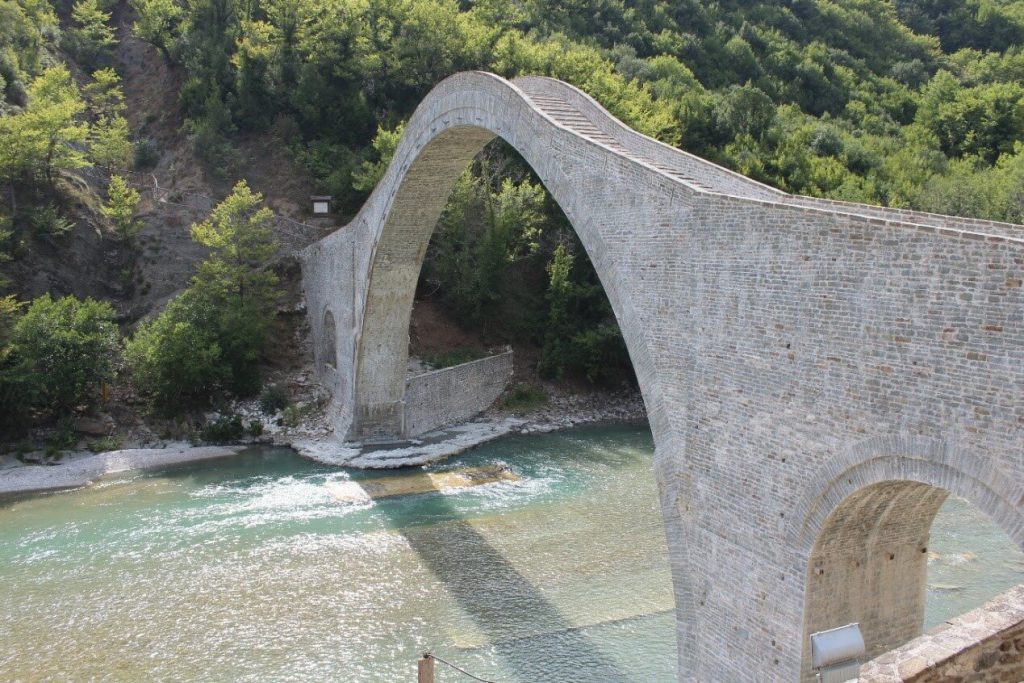
Plaka was named after the place coming into being from a huge craggy rock (Plaka) of the mountain, where the bridge is founded on one side. The rock starts from the top of Xerovouni mountain and ends at the right bank of Arachthos. Plaka is a historical point, as the Greeks under the strategy of Mitros Koutelidas crushed the army of Topal Ali Pasha on July 27, 1821, at the battle of Plaka. However, the strategic mistake of the Greeks that followed, who left only 50 men in their outpost, allowed Topal Ali Pasha with 5,000 men to recapture the area. On 3 February 1878, during the uprising against the Ottomans, Greek troops, under the orders of Konstantinos Kottikas, defeated the Ottoman Guard of the bridge and forced them to capitulate.
The heavy winter of Tzoumerka mountain forced the shepherds of the surrounding mountain villages to descend to the plain of Arta and spend the winter with their flocks. The traders and the workers descended to Arta, in order to sell their products and find a job at the fertile flatland of Arta. Below the village of Raftanei, near the settlement of Mouhousti, where is the Monastery of the Birth of Virgin Mary (Monastery of Panaghia Mouhoustiotissa), there is the historic strait of Plaka. For years, however, they crossed the Arachthos river from an old stone bridge to the historic and glorious strait of Plaka. But in 1860, this unsteady structure collapsed, as the momentum of the water moved the rock that supported it. The merchants and shepherds were cut off in anticipation of the flood.
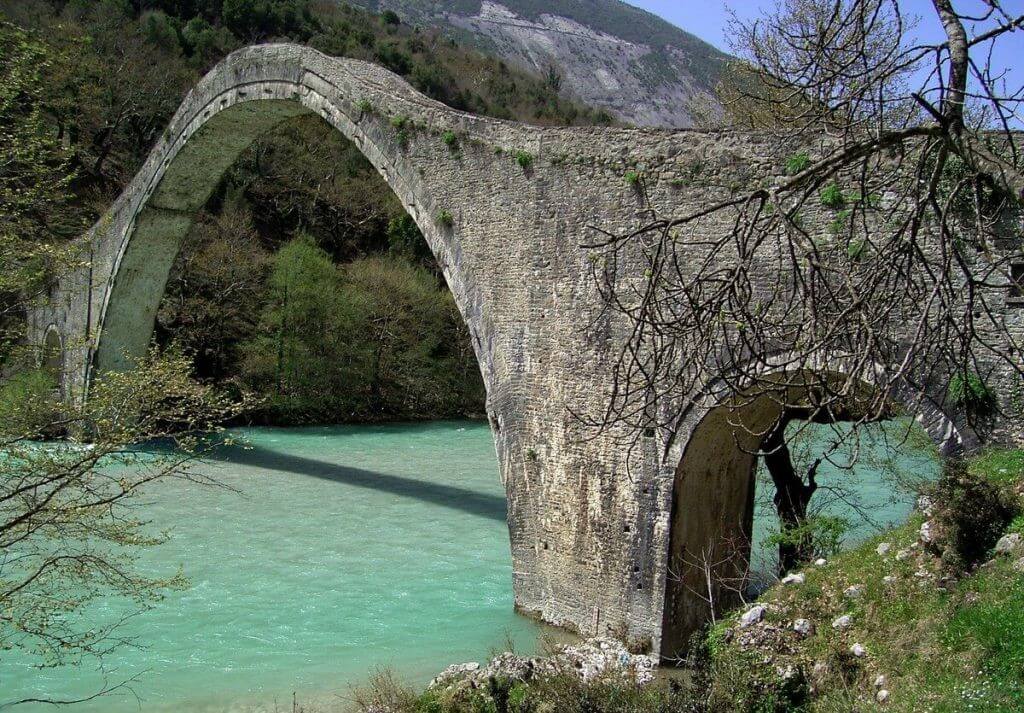
Local communities decided to construct a new bridge, which was unfortunately collapsed again during the celebration of the inauguration. An article of Spyridon Mantas, one of the most significant researchers of Bridges in Epirus, at the feuilleton Epta Imeres of Kathimerini paper, Sunday 22 of May 2005, shows the dramatic moments: Villagers and officials had already returned to their homes. However, the master-mason George Frontzos was lying on the ground with his eyes closed, unable to believe what he had seen. The other craftsmen, in the distance, stopped talking, the young assistance builders were crying, and the craftsman-Kostas Bekas, with words of consolation, was trying to calm the master-mason George and to persuade him to climb on the mule, to leave from Pramanta. The master-mason George Frontzos from Konitsa and Kostas Bekas from Pramanta were qualified together to undertake the project of construction. However, they disagreed on the final plan: Frontzos wanted the bridge with a lowered arch, while Bekas preferred it with a semi-circular arch, even though it would rise very high and more expensive. At the meeting, for reasons of cost, the master-mason George Frontzos was preferred. Ioannis Loulis, who was the main sponsor of construction, recommended George Frontzos as the constructor. But things, as we aforementioned, turned out badly (Μαντάς, 2005).
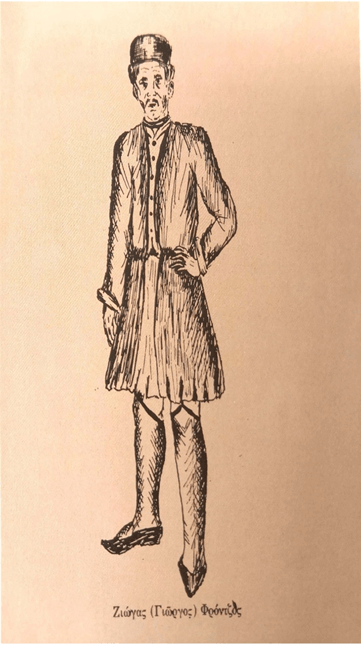
In 1866, the Bridge was rebuilt in its current form (before the collapse of 2015) by the master-mason Kostas-Bekas, sponsored by the Communities of Agnanta (48,900 piasters), Pramanta (32,000 piasters), and Melissourgoi (96,000 piasters). The benefactor Ioannis Loulis, in addition to the 90,000 piasters he had spent in the previous effort, offered another 2,000 piasters. A project with a total cost of 187,000 piasters, but the communities were not happy, as they were financially and mentally exhausted.
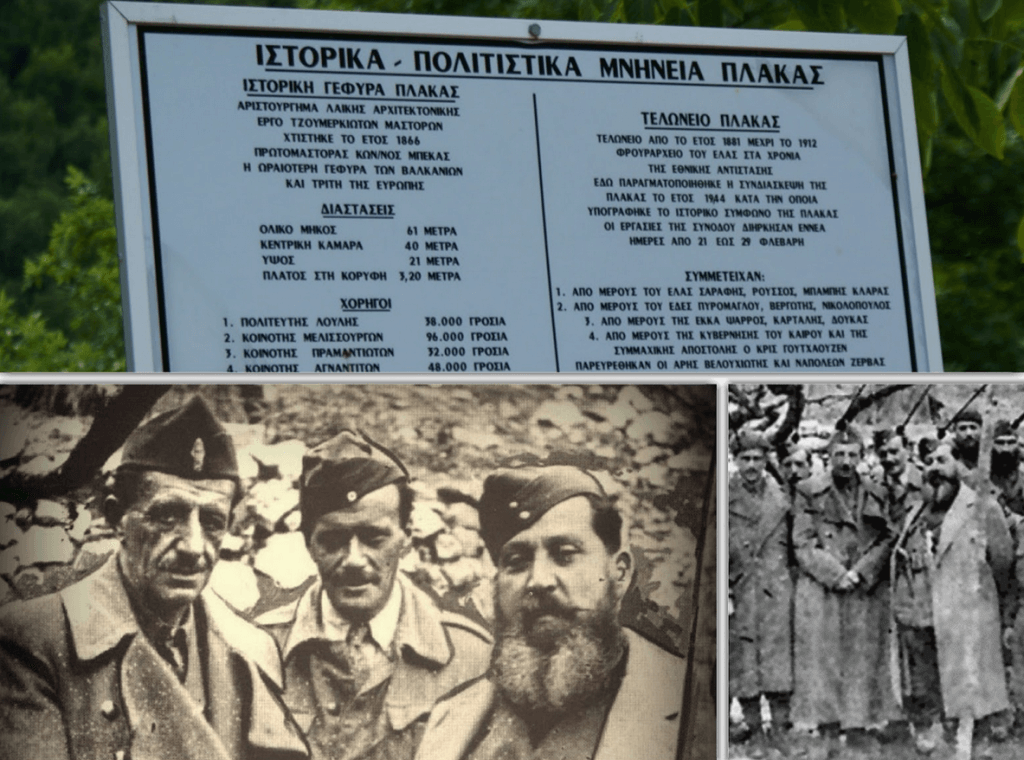
The Plaka-Myrofyllo Agreement (21-10 February 1944)
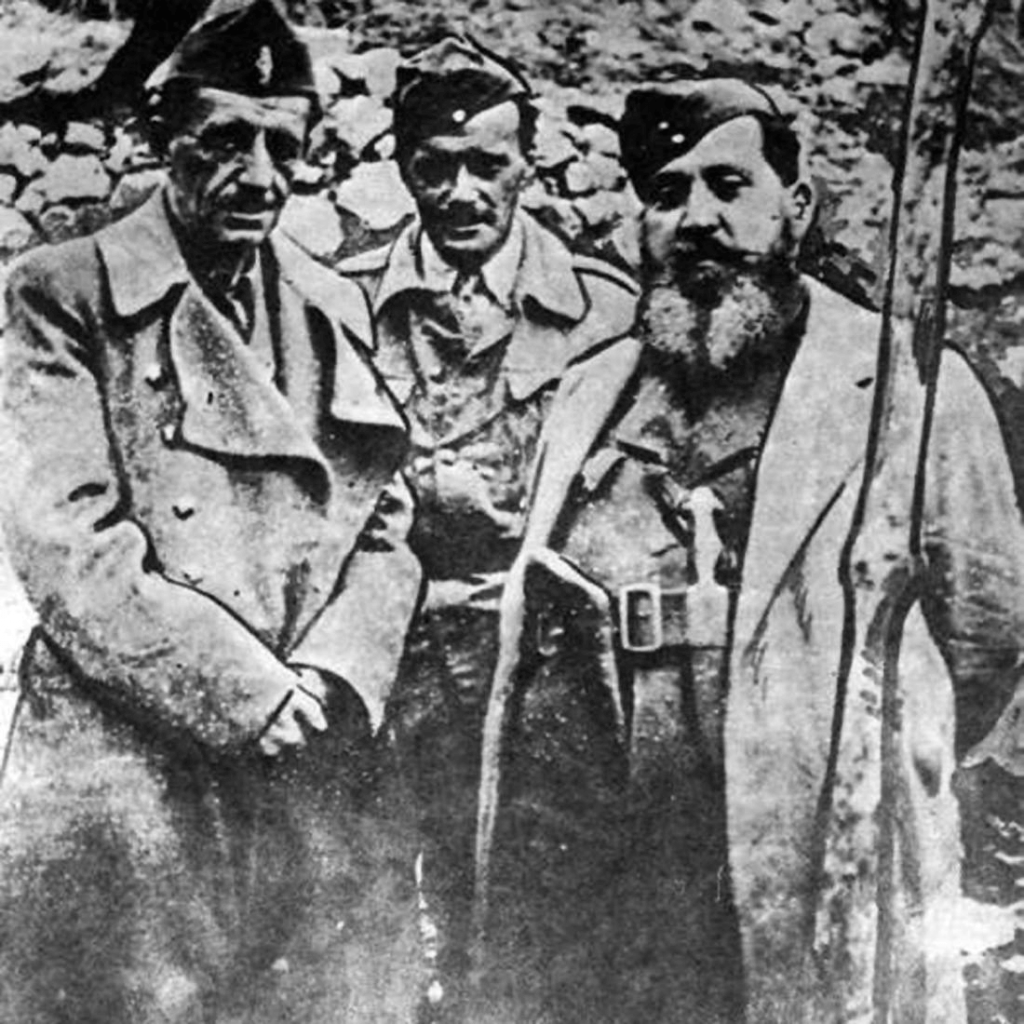
In October 1943 took place the all-out attack of ELAS against EDES. The highly polarized struggle of those years between the left and right ideologies and the first conflicts of 1943-1944 resulted after the Greek Civil War. The truce of hostilities between ELAS and EDES was signed on 4 February 1944 in the village of Myrofyllo of Trikala and was the beginning of negotiations between EDES and ELAS. Then at the customs office in Plaka of Arachthos, which survives to this day, was signed the final agreement.
The Plaka Agreement took place in 1944 at the Plaka Customs, during which the historic Protocol of Plaka was signed, which stopped the civil hostilities between the main and at the same time conflicting Greek resistance organizations, after nine days (from the 21st of February 1944 until 29th of February 1944) of negotiations.
From the EDES side, Komnenos Pyromaglou, Petros Nikolopoulos, and Nikos Vergetis attended the negotiations. Zervas also attended the negotiations at Plaka, when, shortly before the end of negotiations, they transferred the seat from Myrofyllo to Plaka. From the ELAS side, attended Stefanos Sarafis, the political advisors Petros Roussos (Nikolas) and K. Despotopoulos, and Mpampis Klaras(the brother of Aris Velouchiotis) From the EKKA side, attended Dimitrios Psarros and Georgios Kartalis, who also chaired the conferences.
On the Allied side, Woodhouse participated, who was also responsible for many delicate manipulations during the negotiations.
The final two meetings on 28 and 29 February were the most crucial. On the afternoon of the 29th of February, was signed the Protocol of the Myrofyllo-Plaka agreement. The Protocol provided for the following:
- cessation of hostilities between ELAS-EDES
- preservation of the territories held by each group until the day of the agreement
- their joint action against the occupier
- Joint Committee to oversee the implementation of the Protocol
- release of prisoners and hostages
- supply for all resistance organizations
- condemnation of the security battalions and the occupying government of Rallis.
Bailey bridge
In the summer of 1959, when the first cars appeared, the construction of foundations for the metal bridge began. This Bridge at a small distance from the stone bridge facilitated the passage of motor vehicles. In August 1960, the Army Technical Service detached the Bailey bridge, which was at that time next to the Bridge of Arta, and placed it next to the Bridge of Plaka. Since then, one of the 96 Bailey-type iron bridges in the country, stands next to the Plaka Bridge and still provides its services.
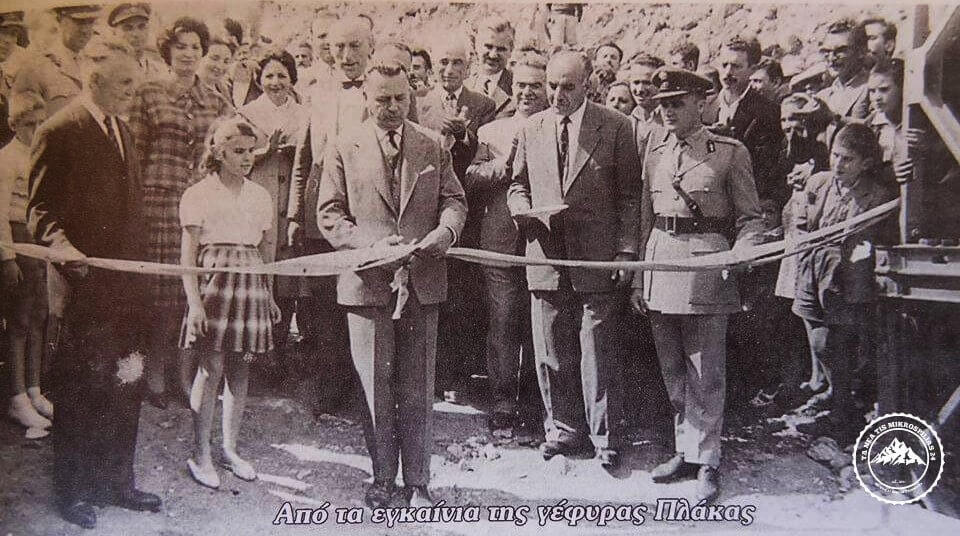
Collapse of the old bridge
The bridge connected the two banks for 150 years until February 1, 2015, when it collapsed. The causes for the collapse were synergistic: Some problems in its geometry, the extreme environmental conditions during the collapse, the ferocity of the river at that time, problems in the foundations, the deterioration of its joint mortars, the use of incompatible materials in recent restorations, as well as past damages due to an explosion in WWII, acted synergistically towards its collapse. When the bridge collapsed, the water supply to Arachthos is estimated at 1250 m3 /sec. Arachthos at that time could fill a pool of Olympic dimension swimming pool in about 3 seconds. However, according to statistics, the Bridge had withstood at least another four times a corresponding flood in the last 47 years.
The restoration of the Plaka Bridge
That disaster shook the whole country, and the request for restoration was massive. The National Technical University of Athens (NTUA) undertook the rehabilitation. The NTUA used as much as possible material from the old structure. Following the style of the master’s mason, the reconstructed Bridge of Plaka is reminiscent of the glamour of the Bridge that was built by Kostas Beκas, and the sacrifices made by the local communities for its construction.
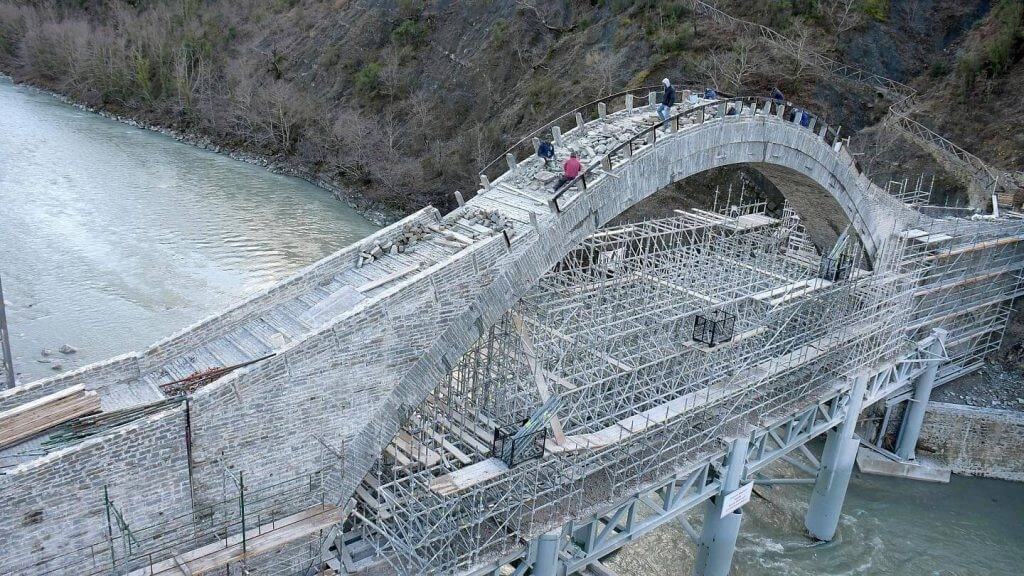
Legends
September 1866: due to the failure of the previous attempt of 1863 to stabilize the foundations of the bridge, a human sacrifice was needed to keep the bridge steady. In Agios Georgios of Monolithi lived an old man, who was almost 100 years old, Spyros Angelis (nicknamed Pleuris). Unmarried but with a large fortune. Let's go and see the bridge which will soon be ready, his friends told him and patiently escorted him to the western pedestal. He greeted the craftsmen, wished them well, and said beautiful words about their art and their labor. They helped him up the scaffolding to enjoy the building. A craftsman handed him his tobacco bag, the old man rolled a cigarette and leaned against the scaffolding, smoking, and chatting. Right behind him where his shadow fell, a craftsman nailed it while building secretly without the old man noticing. Immediately afterward he wished the craftsmen and left. Everything happened as they had arranged; they went up to the village and the secret was well hidden. The old man Pleuris fell ill and before 40 days had passed, he died. His life had ensured the bridge’s stability (story from Michael Pantazis' great-grandmother).
The Myth about the walled up old man from Monolithi villageThe sheep of a local shepherd were grazing at a small distance from that point, where the stonemasons were building the Bridge of Plaka. The stonemasons helped the shepherd to cross his sheep from one bank to the other. He wanted to thank them for this good act and gave them as a gift a bell (locally called ‘kipros’). The stonemasons placed that bell on the highest arch, and for many years it remained at this position providing its services. The bell has proved necessary, being a particularly useful instrument. Before the construction of the protective built parapet, the ringing of the bell warned humans not to cross the bridge when strong winds were blowing. Besides, the wind vane is typically used as an architectural ornament to the highest point of a building, and in Epirus, in the case of some stone bridges, they used to hang a bell on the highest arch. But, before the construction of the 'guardrail', the Bridge was so safe, that the people used to cross it crawling, and the big cattle with covered eyes. In 1912-1913, with the outbreak of the Balkan Wars, the Greek soldiers used this bell as a target and destroyed it.
The old bellChronological timeline
For years, the traders and the workers crossed the Arachthos river from an old stone bridge to the historic and glorious strait of Plaka. But in 1860, this unsteady structure collapsed.
Local communities decided to construct a new bridge, which was unfortunately collapsed again during the celebration of the inauguration.
In 1866, the Bridge was rebuilt in its current form (before the collapse of 2015) by the master-mason Kostas-Bekas, sponsored by the local Communities and the benefactor Ioannis Loulis. A project with a total cost of 187,000 piasters.
During the WWII, the Bridge of Plaka was bombed by the Germans forces, having only minor damage.
The Plaka-Myrofyllo agreement was the peace agreement signed on 29 February 1944 between the main and simultaneously warring Greek resistance organisations, EAM-ELAS, EDES, and EKKA. It was adopted in the presence of the British Colonel Chris Woodhouse as the representative of the Greek Military Command of Egypt, at a time when Greece was still under German-Bulgarian occupation during World War II.
In 1984, the Laboratory of General Geodesy took over the geographical documentation of the Bridge. The bridge was included in the programme of the Service of Modern Monuments and Technical Works of Epirus. The restoration works were carried out by the Service.
During the year 2001, restoration of stone protective parapets, local repairs, masonry grouting, maintenance of the exterior (roadway - cobblestone) of the bridge, cleaning of the facades and the surrounding area from plant organisms were carried out.
The bridge connected the two banks of the river for 150 years until February 1, 2015, when it dropped down after heavy rainfall.
1 February 2015- Informal inauguration 11-07-2020
The project to restore and reconstruct the bridge has won one of 24 European Heritage Awards/ Europa Nostra Awards in 2021 handed out on Tuesday 25 May 2021.
Statement of Significance
Constructional characteristics of the historical Bridge of Plaka
Design | one- arch stone bridge |
Architecture type | traditional stone bridge architecture of the region |
Construction material | sandstone (ασβεστικός ψαμμίτης) |
Total length | 61 meters |
Width at the top | 3.20 meters |
Height | 18.10 meters |
Arches | One Arch with two smaller relieving openings on each side of the main arch (east opening width: 6,5 meters/ western opening width: 5 meters) |
Arch opening | 39.78 meters |
Pedestals | 2 |
Manufacturer | master mason Kostas Bekas |
Sponsors | G. Loulis, An. Lytras, local inhabitants, and communities |
Total construction cost | 187,000 piasters |
Opening of the Old Bridge of Plaka | 1866- opening of the reconstructed Bridge of Plaka: 2021 |


This site was formerly a wooded area, which belonged to the monastery of Plaka (Monastery of Panaghia Mouhoustiotissa), located in the area of the village of Raftanei in Ioannina. This monastery was formerly the 'mhousti' (the center of trade in the region). It also had goats and sheep, that grazed in the location of Monolithi Plaka. The inhabitants of Monolithi, seeing that this area was very suitable for cattle breeding, decided to drive out the cattle of the monastery from there. After a bloodless scuffle, the servants of the Monastery took their cattle and went down to the river. The inhabitants of Monolithi, to intimidate them, rolled stones after them and the crockery of the monastery's shepherds. The abbot being informed of this fact, took the icon of the Virgin Mary by the hand, went out into the courtyard, opposite the Plaka position, and said: «Do you see how your inheritance is being chased? ». And at that time the following paradox happened: the sky at that spot opened and hail and rain began to fall and a river was created that washed out the area of the monastery's jurisdiction so much that a slab (rock) appeared.
The Myth about how the Plaka site was born: Plaka of Monolithi